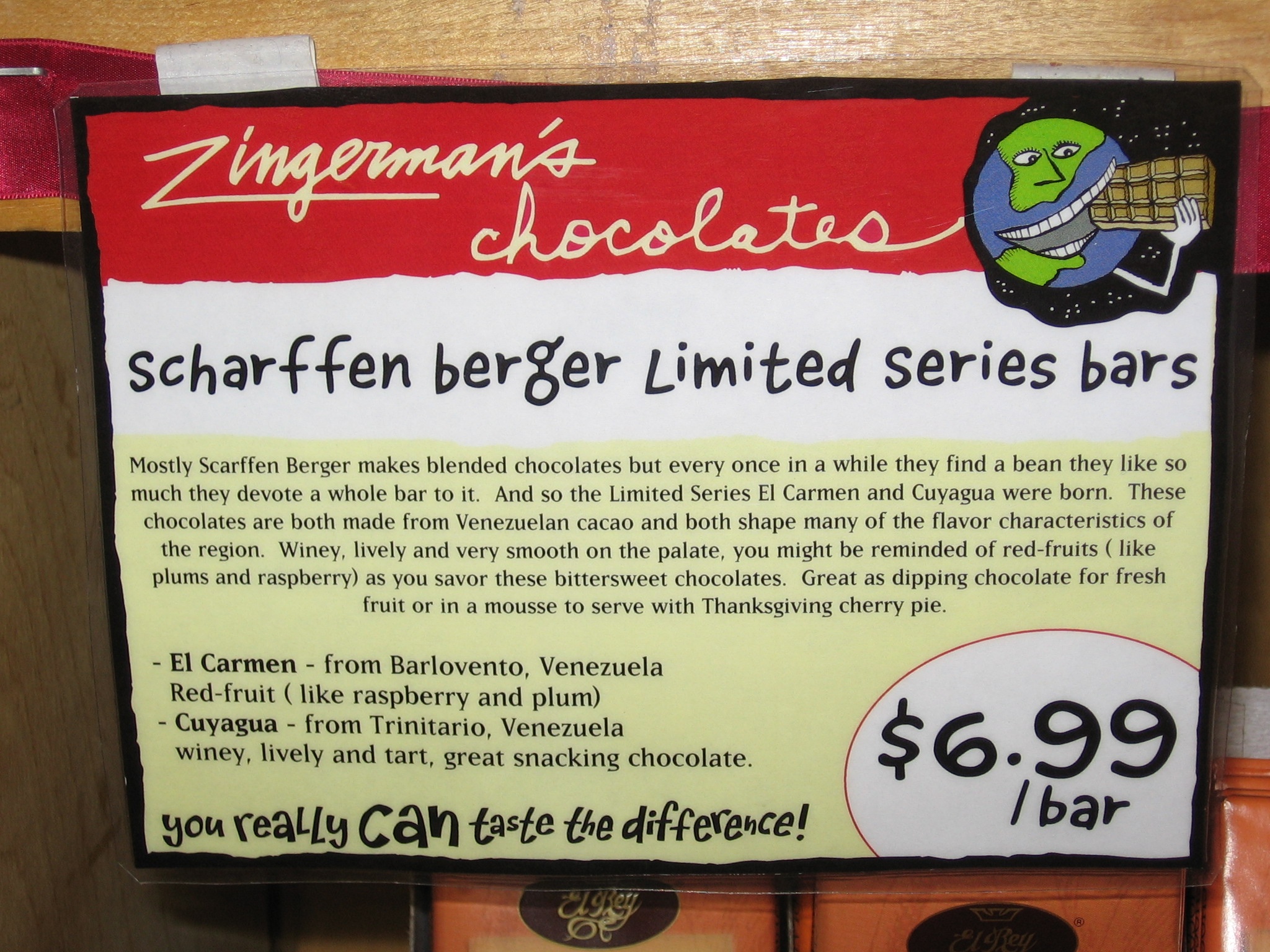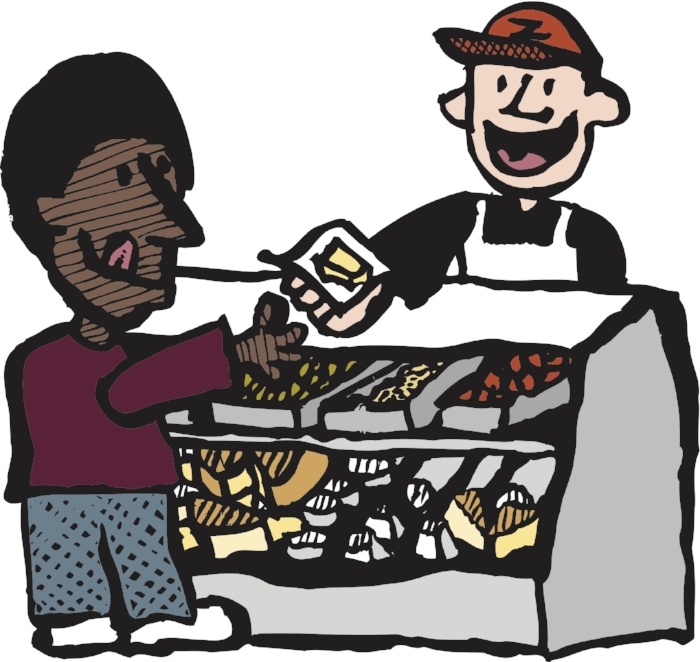Educating Your Customers: Using Every Opportunity to Teach and Sell

For those of us who sell specialty products, customer education has always been part of the selling process. Sometimes we’re offering products that most customers have never heard of. Other times we have items with familiar names but vastly superior ingredients or construction. Almost always the prices that we charge are higher than what is being charged somewhere else in our market for something that can SEEM to be the same thing. Our success depends upon customers understanding the differences between our products and the competition’s.
Every customer interaction is an opportunity for education, although some teaching is more overt than others. Here are three key opportunities for customer education:
Signs that Sell (and Educate)
We define a great Zingerman’s sign as “a sign that sells more product.” And as mentioned above, selling product typically involves educating/informing the customer about why this particular product is special.
We’ve found that the most effective signs have three key elements:
1. Name of the Product
If the purpose of your sign is to sell, then the name that you give your product should make customers more likely to buy it. The name should catch customers’ attention. It should reflect your company’s look and feel and help differentiate your product from that of the competition. The name on the packing slip may not be the name you want to put on your sign. “Goat brick” may be exactly what the supplier calls her product, but does it sound especially appealing? Who wants to eat a brick? Even one made out of goat? What about “Hand-ladled Farmhouse Goat Cheese”? Much more appetizing!
 2. Reason to Buy
2. Reason to Buy
Sign copy is a great opportunity to educate customers about products. Although we’d like to interact personally with every single customer, that simply isn’t possible. Sign copy sells to customers who would rather just browse around on their own, who are waiting in line, or who have trouble hearing over the clamor in most retail environments. Answering the most common unasked questions makes good sign copy. When it comes to food, two common questions are “What does it taste like?” and “How can I use it?” If your sign says “Full-flavored, fruity olive oil that’s perfect for pasta,” you’ve answered both questions.
Ingredients are often a differentiator for specialty products. For example, Zingerman’s pastries are made from fresh eggs and real butter, and we want to make sure people know that. For most people those ingredients are much more appetizing than “Egg substitute (Potato Starch, tapioca starch flour, leavening (calcium lactate [not derived from dairy], calcium carbonate, citric acid), sodium carboxymethylcellulose, methylcellulose) and vegetable oil.” But we also want customers who have an egg allergy—or are vegan—to have the information they need to buy accordingly. The bottom line is to figure out and communicate what will be most meaningful to the customer.
3. Price
Last, but by no means least, an effective sign needs to include the price. When customers aren’t sure about the price, they tend not to buy because they don’t want to look (or feel) stupid when they get to the register. Some people will ask. Many will not; they’ll just walk on—without that product in their basket. Make sure the price is large enough to be seen easily.
Staff who Sell (and Educate)
Selling specialty products effectively involves learning about our customers, learning about our products and then putting that information together to productively educate our customers about the products. What the staff says—through words, tone of voice, body language and overall energy—speaks volumes to the customer.
Selling Tip #1: Prepare. To be an effective salesperson, you need to do some homework and educate yourself. Of course general knowledge about your products is important, but it’s also important to know what new items have been stocked since you last worked and what key items you’re currently out of (and when more is expected). Having at least two specific products in mind gives you a good place to start when you’re helping a customer who’s looking for recommendations.
To be an effective salesperson, you need to do some homework and educate yourself. Of course general knowledge about your products is important, but it’s also important to know what new items have been stocked since you last worked and what key items you’re currently out of (and when more is expected). Having at least two specific products in mind gives you a good place to start when you’re helping a customer who’s looking for recommendations.
Selling Tip #2: Engage the customer.
Getting your customers talking—and then actively listening to what they say—is the best way to find out what they need. Hint: the opening line “can I help you?” almost always engenders the reply “no, I’m just looking” and is therefore very ineffective as a way to engage customers. Much better is to ask open-ended questions. In addition to the words that come out of your mouth, you need to engage the customer with your body language. Make eye contact. Smile. Come out from behind the case and stand shoulder-to-shoulder with the guest so that you can look at the display together.
Selling Tip #3: Make selling suggestions early. At Zingerman’s, we’ve found that introducing an impulse or add-on item as part of the initial interaction with the customer significantly increases the chances that they will purchase the product. For example: “I see you’re here looking at olive oils and I’ll be glad to help you with those, but first would you like to try a slice of our pecan raisin bread—fresh off the Bakehouse truck? It’s actually one of our most popular hostess gifts. Now, what questions can I answer for you about these olive oils?” At worst, you’ve educated the customer about a product that they choose not to buy—at least not today. At best you’ve introduced them to a new favorite.
At Zingerman’s, we’ve found that introducing an impulse or add-on item as part of the initial interaction with the customer significantly increases the chances that they will purchase the product. For example: “I see you’re here looking at olive oils and I’ll be glad to help you with those, but first would you like to try a slice of our pecan raisin bread—fresh off the Bakehouse truck? It’s actually one of our most popular hostess gifts. Now, what questions can I answer for you about these olive oils?” At worst, you’ve educated the customer about a product that they choose not to buy—at least not today. At best you’ve introduced them to a new favorite.
Selling Tip #4: Narrow the choices for the guest.
As retailers, we are all justifiably proud of our product selection and of our knowledge of what we carry and why it’s great. Unfortunately our selection—and our knowledge—can sometimes overwhelm a customer. Especially the customer with a long to-do list and limited time. This is the customer who needs effective suggestions, not a recitation about how many brands of chocolate we carry. No guest wants to feel stupid or patronized. When making suggestions, keep your tone of voice helpful and always follow the customer’s lead. If they are responding positively to your suggestions, proceed. If not, take a step back and ask more questions.
Selling Tip #5: Convey the value of every product.
Customers want confirmation that they made a good purchase (especially if it’s a gift). And as retailers we want them to leave our businesses feeling that they made a great decision when they decided to come shop in our store. In my experience, one of the best ways to help customers feel smart is to validate their product selections by giving short, but meaningful “testimonials.” Obviously, this is where staff product knowledge comes in handy: “Mmmm. Pecan Raisin bread. Did you know there’s over half a pound of pecans and raisins in every loaf?” or “We import this olive oil direct from Italy, so it’s a Zingerman’s exclusive.”
Classes and Tastings for More In-Depth Education
Many Zingerman’s customers want to learn more than what can be shared during normal retail transactions. For those customers (and their friends and families!) we offer a variety of product classes and tastings. Most of these classes last about 2 hours (although BAKE, the teaching kitchen at Zingerman’s Bakehouse has classes of up to a week for serious home bakers.)
If you’ve been thinking about developing a customer class/tasting but aren’t sure where to start, here is a basic to-do list.
![]() Define your audience.
Define your audience.
How much knowledge will customers bring into the class? That will determine whether you design a very basic, introductory class or one that is more technical and in-depth.
![]() Establish learning objectives.
Establish learning objectives.
What do you want your customers to know or be able to do after they complete this class?” As a rule of thumb, a 2-hour class should have between 3-5 learning objectives. More than that and you’re trying to cram in too much material. You want the classes to be engaging and fun, but you also want to use them to educate your customers about why the products you sell are different—and better—than what they can get elsewhere. For a customer cheese class, a good learning objective might be: Recognize the visual and flavor differences between a variety of artisan and factory produced cheeses.
![]() Develop an outline.
Develop an outline.
Once you’ve established your learning objectives, you’ve effectively defined what you will focus on in the class. One of the most common mistakes people make is to try and cram way too much information into not enough time. As you’re developing your outline, keep your learning objectives in mind. If the topic you’re thinking of including doesn’t directly address one or more of the learning objectives, it should probably be left out.
![]() Address a variety of learning styles.
Address a variety of learning styles.
Different people learn in different ways, so make sure to include formats targeted to visual, auditory and kinesthetic learners. In a food class, it’s easy! For example, in addition to explaining the differences between two cheeses (auditory), provide a handout (visual) and include a comparative tasting (kinesthetic).
![]() Teach it, refine it and teach it again.
Teach it, refine it and teach it again.
Steps 1-4 are all about planning; taking the up-front time necessary to make sure that when you teach the class, you achieve the results you were hoping for. But even with all the planning in the world, your class won’t be as good the first time you teach it as it will be the second time—provided you pay attention to what works and what doesn’t, and make adjustments accordingly. When you actually teach a class, not only do you find out what explanations and exercises hit home and which don’t, you also become more familiar and comfortable with the material yourself.
——
The more we think about customer education as part and parcel of the selling experience, the more we are likely to recognize opportunities to do both. And don’t forget that materials developed to educate customers also work really well as training tools for new staff. Now—go forth, educate, sell and have fun!
*This piece was originally published in Gourmet Retailer.
 Back to Library
Back to Library




